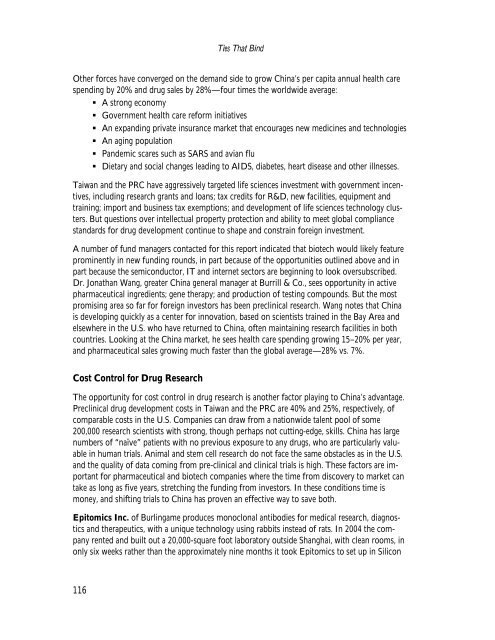Ties That Bind - Bay Area Council Economic Institute
Ties That Bind - Bay Area Council Economic Institute
Ties That Bind - Bay Area Council Economic Institute
You also want an ePaper? Increase the reach of your titles
YUMPU automatically turns print PDFs into web optimized ePapers that Google loves.
116<br />
<strong>Ties</strong> <strong>That</strong> <strong>Bind</strong><br />
Other forces have converged on the demand side to grow China’s per capita annual health care<br />
spending by 20% and drug sales by 28%—four times the worldwide average:<br />
� A strong economy<br />
� Government health care reform initiatives<br />
� An expanding private insurance market that encourages new medicines and technologies<br />
� An aging population<br />
� Pandemic scares such as SARS and avian flu<br />
� Dietary and social changes leading to AIDS, diabetes, heart disease and other illnesses.<br />
Taiwan and the PRC have aggressively targeted life sciences investment with government incentives,<br />
including research grants and loans; tax credits for R&D, new facilities, equipment and<br />
training; import and business tax exemptions; and development of life sciences technology clusters.<br />
But questions over intellectual property protection and ability to meet global compliance<br />
standards for drug development continue to shape and constrain foreign investment.<br />
A number of fund managers contacted for this report indicated that biotech would likely feature<br />
prominently in new funding rounds, in part because of the opportunities outlined above and in<br />
part because the semiconductor, IT and internet sectors are beginning to look oversubscribed.<br />
Dr. Jonathan Wang, greater China general manager at Burrill & Co., sees opportunity in active<br />
pharmaceutical ingredients; gene therapy; and production of testing compounds. But the most<br />
promising area so far for foreign investors has been preclinical research. Wang notes that China<br />
is developing quickly as a center for innovation, based on scientists trained in the <strong>Bay</strong> <strong>Area</strong> and<br />
elsewhere in the U.S. who have returned to China, often maintaining research facilities in both<br />
countries. Looking at the China market, he sees health care spending growing 15–20% per year,<br />
and pharmaceutical sales growing much faster than the global average—28% vs. 7%.<br />
Cost Control for Drug Research<br />
The opportunity for cost control in drug research is another factor playing to China’s advantage.<br />
Preclinical drug development costs in Taiwan and the PRC are 40% and 25%, respectively, of<br />
comparable costs in the U.S. Companies can draw from a nationwide talent pool of some<br />
200,000 research scientists with strong, though perhaps not cutting-edge, skills. China has large<br />
numbers of “naïve” patients with no previous exposure to any drugs, who are particularly valuable<br />
in human trials. Animal and stem cell research do not face the same obstacles as in the U.S.<br />
and the quality of data coming from pre-clinical and clinical trials is high. These factors are important<br />
for pharmaceutical and biotech companies where the time from discovery to market can<br />
take as long as five years, stretching the funding from investors. In these conditions time is<br />
money, and shifting trials to China has proven an effective way to save both.<br />
Epitomics Inc. of Burlingame produces monoclonal antibodies for medical research, diagnostics<br />
and therapeutics, with a unique technology using rabbits instead of rats. In 2004 the company<br />
rented and built out a 20,000-square foot laboratory outside Shanghai, with clean rooms, in<br />
only six weeks rather than the approximately nine months it took Epitomics to set up in Silicon








